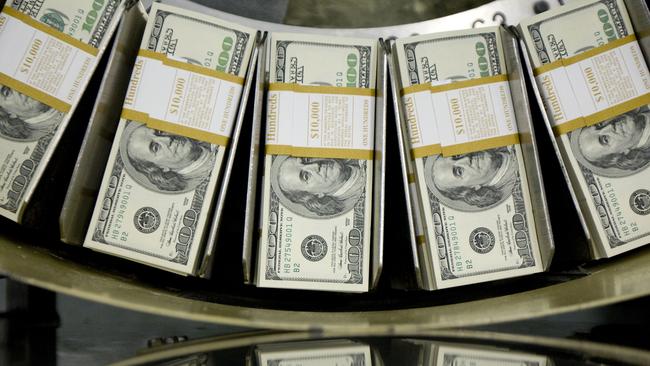The US dollar would be the first casualty of a trade war
While a trade war could wreak havoc, an inward US turn would also erode the greenback’s strength and the privileges it confers.

With officials in his administration saying that no final decision on the tariffs has yet been made, the president could yet change his mind and that there might or might not be exemptions for some countries or companies, thus it remains unclear whether Trump has actually fired the first shot in what could develop into a global trade war.
What is clear is that over the past year there has been a divergence in the conventional linkage between the US dollar and US interest rates.
Over the past year, even as the US Federal Reserve has been raising US rates and embarking on an unwinding of the massive hoard of US bonds and mortgages it accumulated in response to the financial crisis, the US dollar has been weakening.
Against a basket of its major trading partners the dollar has depreciated nearly 12 per cent. Over the same period, the yield on US 10-year Treasuries has climbed from about 2.5 per cent to around 2.9 per cent (after touching 2 per cent last September).
With the US Federal Reserve Board signalling at least three more 25 basis point rate rises this year — the slightly hawkish tone of new chairman Jerome Powell has the market speculating about a fourth — the rate differential between the US and its trading partners looks set to widen.
The decline in the currency is despite the strong performance of the US economy, and stockmarket over the year and the prospect of even stronger growth as Trump’s tax cuts flow through.
Or perhaps it’s because of those factors and the prospect that the administration will implement more of its agenda, including the “America First” trade policies that appear to be next on the agenda.
The Trump tax cuts have been estimated to add at least US1 trillion and perhaps as much as $US1.5 trillion to US deficits over the next decade. It’s already facing a deficit of about $US1 trillion this year and something larger in 2019. US government debt, now more than $US20 trillion and more than 100 per cent of GDP, is expected to reach $US30 trillion within a decade.
Even without the wildcard of an outbreak of tit-for-tat protectionism, the weakening of the dollar, even as US growth is surging and US bond rates are rising, suggests a wariness among foreign investors that is at odds with the exuberance of Trump, his officials and the US stockmarket.
In effect, foreign investors in US Treasuries appear to be focused on the longer term implications of the larger US deficits the administration is spawning and are either seeking a premium as insurance against a deteriorating credit risk or diversifying their holdings away from the US because of the perceived higher risk.
The improvements in the eurozone and Japanese economies mean that they do have attractive alternatives to the US even as the US government financing task is soaring.
The Fed’s balance sheet-downsizing is now on a form of autopilot. Over the course of this year the Fed will not reinvest — not subscribe for new issues of Treasuries -- $US230bn of the $US450bn of its $US4.5 trillion of holdings that will mature this year.
That’s a major factor, albeit not the only one, in the US Treasury department’s plans to raise a net $US955bn from debt markets this year, up from $US520bn last year.
Thus, at a time when foreign investors appear reluctant to invest in US government debt the combination of Fed actions and the administration’s fiscal policies are already increasing both the issuance of debt and its cost.
A trade war could exacerbate the trends.
Not only has Trump’s announcement, without any developed policy detail, highlighted divisions within his administration and party, but his view that “trade wars are good, and easy to win” betrayed a disturbing lack of understanding of global trade, global supply chains and the impact on the US and the world of a full-scale outbreak of protectionism.
Trump measures the fairness of the US dealings with other economies by the size of the trade deficits it runs. It doesn’t appear to have occurred to him or some of his more hawkish advisers on trade that wiping out those deficits would lead to higher interest costs on government debt and a lower standards of living overall in the US than would otherwise be the case.
Former Reserve Bank board member Warwick McKibbin, writing elsewhere this week, made the point that if America’s major creditors — and China, with $US1.2 trillion or so of Treasury bonds is its largest — were to sell their holdings of US government debt, the US dollar would fall heavily, US bond rates would soar and US savings would have to rise and investment to fall.
It’s probably unlikely that China or Japan (which holds $US1 trillion of Treasuries) would just dump their holdings, given that would crystallise massive losses as their supply forced bond prices to fall (and yields to rise).
It would appear, however, that they and other major investors in US government debt have already stopped reinvesting all the proceeds of their maturing securities. Towards the end of last year both China and Japan’s holdings started to edge down.
Whether its nervousness about the outlook for the US economy — a concern about the rising deficits and, perhaps, in the near term the impact on US inflation and rates of the Trump turbocharging of an economy already operating near capacity — a desire to diversify their exposures now that there are other attractive options or a quiet statement of protest at the “America First” rhetoric the reduced foreign interest in US government debt helps explain the depreciation in the US dollar.
If Trump pushes the button on a global trade war the trends would be amplified in a self-reinforcing way — the US dollar would continue to fall, encouraging foreigners to sell before their holdings were further devalued even without the element of retaliation that McKibbin was suggesting.
US rates would spike and, even if the Fed responded by halting its balance sheet reduction program and slowing its normalisation of US rates, the market would take independent action. The US deficits still have to be funded, if not by foreigners then from the domestic savings pool.
The other risk the US would run if trade tensions escalate is that it could erode the status of the US dollar as the only global reserve currency, a status that has enabled the US and its companies to borrow more cheaply relative to their competitors in the post-war period.
China, in 2015, was successful in having its currency included in the International Monetary Fund’s basket of “special drawing rights” or SDRs, alongside the US dollar, the British pound, the euro and the Japanese yen.
That was part of a lengthy and continuing — and steadily more successful — effort to see more international transactions settled in yuan, lowering borrowing costs and transaction risks and costs for its companies and conferring status on the currency.
While a trade war would be damaging to China and the eurozone (which has also long-harboured ambitions that the euro could rival the US dollar’s status) an insular America could undermine, not only the value, but the pre-eminence of the US dollar and the benefits that confers.






Donald Trump’s thought bubble on steel and aluminium tariffs adds another ingredient to an already confused relationship between US interest rates and the US dollar.